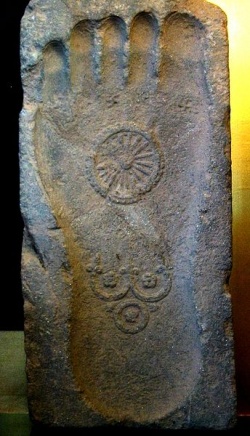Buddhist symbolism
Buddhist symbolism is the use of Buddhist art to represent certain aspects of dhamma, which began in the 4th century BCE. Anthropomorphic symbolism appeared from around the 1st century CE with the arts of Mathura and the Greco-Buddhist art of Gandhara, and were combined with the previous symbols. Various symbolic innovations were later introduced, especially through Tibetan Buddhism.
Early symbols
Footprint of the Buddha. 1st century, Gandhara, with depictions of the triratna and the Dharmacakra.
It is not known what the role of the image was in Early Buddhism, although many surviving images can be found, because their symbolic or representative nature was not clearly explained in early texts. Among the earliest and most common symbols of Buddhism are the stupa, Dharma wheel, and the lotus flower. The dharma wheel, traditionally represented with eight spokes, can have a variety of meanings. It initially only meant royalty (concept of the "Monarch of the Wheel, or Chakravatin), but it began to be used in a Buddhist context on the Pillars of Ashoka during the 3rd century BC. The Dharma wheel is generally seen as referring to the historical process of teaching the buddhadharma, the eight spokes referring to the Noble Eightfold Path. The lotus, as well, can have several meanings, often referring to the quality of compassion and subsequently to the related notion of the inherently pure potential of the mind.
Other early symbols include the trisula, a symbol used since around the 2nd century BC, and combining the lotus, the vajra diamond rod and a symbolization of the three jewels (The Buddha, the dharma, the sangha). The swastika was traditionally used in India by Buddhists and Hindus to represent good fortune. In East Asia, the swastika is often used as a general symbol of Buddhism. Swastikas used in this context can either be left or right-facing.
Early Buddhism did not portray the Buddha himself and may have been aniconic. The first hint of a human representation in Buddhist symbolism appear with the Buddha footprint.
Theravada symbolism
In Theravada, Buddhist art stayed strictly in the realm of representational and historic meaning. Reminders of the Buddha, cetiya, were divided up into relic, spatial, and representational memorials.
Although the Buddha was not represented in human form until around the 1st century AD (see Buddhist art), the Physical characteristics of the Buddha are described in one of the central texts of the traditional Pali canon, the Digha Nikaya, in the discourse titled "Sutra of the Marks" (Pali: Lakkhana Sutta) (D.iii.142ff.).
These characteristics comprise 32 signs, "The 32 signs of a Great Man" (Pali: Lakkhana Mahapurisa 32), and were supplemented by another 80 Secondary Characteristics (Pali:Anubyanjana). These traits are said to have defined the appearance of the historical Buddha, Siddhartha Gautama and have been used symbolically in many of his representations.
Mahayana symbolism
Mahayana Symbolism : Ashtamangala In Mahayana, Buddhist figures and sacred objects leaned towards esoteric and symbolic meaning. The Mudras are a series of symbolic hand gestures describing the actions of the characters represented in only the most interesting Buddhist art. Many images also function as mandalas.
Mahayana and Vajrayana Buddhist art frequently makes use of a particular set of eight auspicious symbols, ashtamangala, in domestic and public art. These symbols have spread with Buddhism to the art of many cultures, including Indian, Tibetan, Nepalese, and Chinese art.
These symbols are:
- 1.Lotus flower. Representing purity and enlightenment.
- 2.Endless knot, or, the Mandala. Representing eternal harmony.
- 3.Golden Fish pair. Representing conjugal happiness and freedom.
- 4.Victory Banner. Representing a victorious battle.
- 5.Wheel of Dharma or Chamaru in Nepali Buddhism. Representing knowledge.
- 6.Treasure Vase. Representing inexhaustible treasure and wealth.
- 7.Parasol. Representing the crown, and protection from the elements.
- 8.Conch shell. Representing the thoughts of the Buddha.
Modern Pan-Buddhist symbolism
At its founding in 1952, the World Fellowship of Buddhists adopted two symbols . These were a traditional eight-spoked Dharma wheel and the five-colored flag which had been designed in Sri Lanka in the 1880s with the assistance of Henry Steel Olcott .

